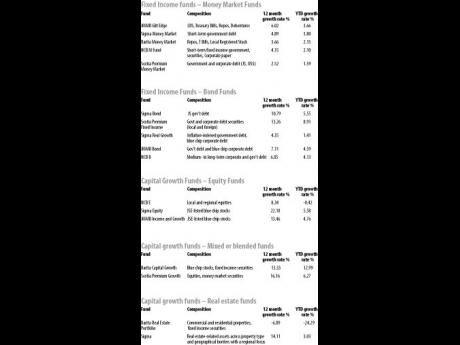Oran Hall | Zooming in on unit trusts
Today, I will look at Jamaica’s five oldest unit trusts and mainly the funds which invest primarily in the Jamaican securities market.
This examination will focus on the composition of the funds, their 12-month growth rate as measured by the percentage increase of their unit values to August 9, 2018, and the year-to-date percentage increase in their unit prices to August 9, 2018 as reported in the Financial Gleaner of August 10, 2018, as laid out in the accompanying graphic.
The funds are categorised as fixed income funds and capital growth funds. The former group comprises money market funds bond funds and the latter equity funds, capital growth funds, mixed funds and real estate funds. These categories, reflecting the types of instruments in which the funds invest, are based on information published by the unit trusts.
- Fixed Income Funds Money Market Funds
Government securities were the preferred instruments although two of the funds listed corporate debt securities as instruments in which they invest. It is worthy of note how different the growth rates of the funds were although they, for the most part, operated in the same market.
- Fixed Income Funds Bond Funds
There is a wide difference in the performance of the funds but these portfolios of long-term bonds did better than the money market portfolios. Of note is that there was a greater inclination to invest in corporate debt instruments than in the case of the money market funds.
One advantage of these funds is that they are capable of deriving returns above current rates when interest rates are falling. When interest rates are increasing, though, there are two disadvantages: the values of the bonds fall and the interest earned lags current rates.
- Capital Growth Funds Equity Funds
These funds invest primarily in equities, but it is not unusual for such funds to invest in a limited amount of fixed income securities. Of note is the wide variation in the performance of the funds with the fund appearing to be spread across more markets recording the lowest growth rate.
Of significance also is the relatively slow growth rate of the funds in the last eight months.
- Capital Growth Funds Funds formally named growth funds
These funds include interest-bearing securities which tend to moderate any decline in fund values which may result from declining stock prices and check any increase in fund values when stock prices are increasing.
Note the sharp difference in the growth rate of the funds in the last eight months and that their values grew at a higher rate than those of the equity funds in that period.
- Capital Growth Funds Mixed or Blended Funds
These funds provide more than one means for generating capital growth. Like the other capital growth funds, their yields generally exceed those of the fixed income funds more so the money market funds but they are more risky.
- Capital Growth Funds Real Estate Funds
Although a means of generating growth, real estate may also inflict losses on investors. Nonetheless, this is a long-term investment vehicle and, as such, is capable of turning around.
MIXED PICTURE
Generally the year-to-date returns show a mixed picture, in some cases, indicating that some funds recorded significant portions of their returns in the last eight months, while the experience of others was quite different.
Even when funds are similar, they do give significantly different returns which may be due to differences in the types of securities which make up the portfolios, the portion of the fund invested in each security and type of security, the markets in which the fund invests and the style, strategy and philosophy of the managers.
- Oran A. Hall, principal author of ‘The Handbook of Personal Financial Planning’, offers personal financial planning advice and counsel. finviser.jm@gmail.com



